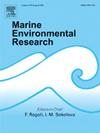Variability of mesozooplankton, abiotic factors and ecological status of marine environment in the north-eastern part of the Black Sea
IF 3
3区 环境科学与生态学
Q2 ENVIRONMENTAL SCIENCES
引用次数: 0
Abstract
Seasonal and interannual dynamics of mesozooplankton abundance, biodiversity, ecological status of the marine environment and concurrent variability of abiotic forcings in the north-eastern part of the Black Sea in 2016–2023 were discussed. Mesozooplankton biomass, total biomass (mesozooplankton plus Noctiluca scintillans), biomass of Copepoda and Parasagitta setosa and harmful heterotrophic dinoflagellate Noctiluca scintillans have been considered along with the water temperature, wind, precipitation and salinity. Natural seasonal dynamic of mesozooplankton, disrupted by the invasion of M. leidyi in 1980s was found to be restored to some extent. General tendencies of interannual variability of mesozooplankton parameters and abiotic factors were documented: biomass exhibited maximums in 2017 and 2022, coincided with negative anomalies of SST and along-coast wind (upwelling conditions) and increased/decreased precipitation/salinity. Steady increase of Shannon index during considered period from 1.5-2 to 2.2–2.6 indicates growing biodiversity in the area. Marine environment had BAD ecological status in 2016–2018 and in 2022–2023 and GOOD one in 2019–2021. Ecological hazard of N. scintillans extensive development have been noticed.
黑海东北部中层浮游生物的变化、非生物因素和海洋环境的生态状况。
讨论了 2016-2023 年黑海东北部中层浮游生物丰度的季节和年际动态、生物多样性、海洋环境的生态状况以及非生物作用力的同期变化。在考虑水温、风力、降水量和盐度的同时,还考虑了中生浮游生物生物量、总生物量(中生浮游生物加Noctiluca scintillans)、Copepoda和Parasagitta setosa的生物量以及有害异养双鞭毛藻Noctiluca scintillans的生物量。发现中浮游动物的自然季节性动态在一定程度上得到了恢复,这种动态在 20 世纪 80 年代因 M. leidyi 的入侵而受到破坏。记录了中生浮游生物参数和非生物因素年际变化的总体趋势:生物量在 2017 年和 2022 年达到最大值,与海温和沿岸风(上升流条件)的负异常以及降水量/盐度的增加/减少相吻合。在此期间,香农指数从 1.5-2 稳步上升至 2.2-2.6,表明该地区的生物多样性不断增加。2016-2018 年和 2022-2023 年海洋环境生态状况为 "BAD",2019-2021 年为 "GOOD"。已注意到 N. scintillans 大规模发展的生态危害。
本文章由计算机程序翻译,如有差异,请以英文原文为准。
求助全文
约1分钟内获得全文
求助全文
来源期刊

Marine environmental research
环境科学-毒理学
CiteScore
5.90
自引率
3.00%
发文量
217
审稿时长
46 days
期刊介绍:
Marine Environmental Research publishes original research papers on chemical, physical, and biological interactions in the oceans and coastal waters. The journal serves as a forum for new information on biology, chemistry, and toxicology and syntheses that advance understanding of marine environmental processes.
Submission of multidisciplinary studies is encouraged. Studies that utilize experimental approaches to clarify the roles of anthropogenic and natural causes of changes in marine ecosystems are especially welcome, as are those studies that represent new developments of a theoretical or conceptual aspect of marine science. All papers published in this journal are reviewed by qualified peers prior to acceptance and publication. Examples of topics considered to be appropriate for the journal include, but are not limited to, the following:
– The extent, persistence, and consequences of change and the recovery from such change in natural marine systems
– The biochemical, physiological, and ecological consequences of contaminants to marine organisms and ecosystems
– The biogeochemistry of naturally occurring and anthropogenic substances
– Models that describe and predict the above processes
– Monitoring studies, to the extent that their results provide new information on functional processes
– Methodological papers describing improved quantitative techniques for the marine sciences.
 求助内容:
求助内容: 应助结果提醒方式:
应助结果提醒方式:


